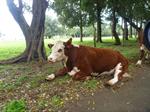 Larger animals can be either a valued component or a serious disruption to a permaculture system. This all depend upon the size and design of the permaculture system, the number of animals and how they are used within the system.
Larger animals can be either a valued component or a serious disruption to a permaculture system. This all depend upon the size and design of the permaculture system, the number of animals and how they are used within the system.
On very large properties (dozens of acres or more); animals such as cattle and deer may roam outer zones in relative freedom. Their presence will provide a source of fertilizer to soil, and their grazing may help keep undesirable plants from producing seed that could spread those plants to inner zones in the permaculture system.
The dynamics at play between animals, plants, soil and the overall permaculture system can be complex and varied from one location to another, in different climates, different typographies and at different times of the year.
As a permaculturist, the challenge for you is to find not only the type and number of animals that are appropriate for your property; but also the best way to manage those animals in that system. Determining these things firstly involves getting a basic understanding of the animals you might use; and then through experimentation, determining what works best for the property you are involved with.
What Animals?
The types of animals which you consider introducing or encouraging in a permaculture system will be different in different countries, regions; and on different size properties.
Consider what animals are suited to the environmental conditions on the property (climate, water and plant resources, topography, etc. We have to match animals to their needs. Some animals need open pasture, others do not. Also consider the amount of space needed. Some animals are herd or flock animals and need to be part of a group; while others may be able to be kept as a single animal.
Domesticated farm animals can be incorporated into a permaculture system, if you have adequate land area for the type of animal concerned. Common larger permaculture species include cattle, deer, horses and alpacas.
Managing Animals
Management of permaculture animals will involve:
- Controlling where animals are located at any point in time (eg. Fencing, tethering)
- Providing food and water to animals
- Choosing appropriate species and breeds
- Reducing or increasing numbers of animals
- Breeding and selling (or trading) livestock
- Ensuring the animals health and wellbeing needs are met
Benefits
Larger Animals can bring the following Benefits to a Permaculture System:
- Controlling weeds.
- Transport –Horses can be used for transport
- Using animals as an energy source (eh. Riding, pulling a cart or plough) –horses, bullocks
- Supply of produce (e.g. milk, cheese, meat, leather, etc.) for self sufficiency
- Supply of produce to sell (as raw products or as value added products).
To learn more about peremaculture: study one of our permaculture courses online.